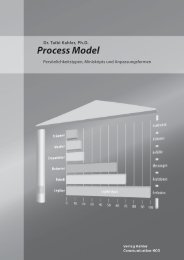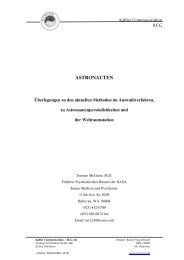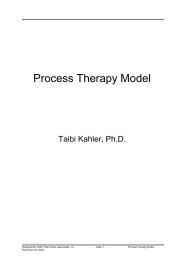Process Therapy Model - bei Kahler Communication
Process Therapy Model - bei Kahler Communication
Process Therapy Model - bei Kahler Communication
You also want an ePaper? Increase the reach of your titles
YUMPU automatically turns print PDFs into web optimized ePapers that Google loves.
• I used the term psychological needs when researching motivation and personality<br />
dynamics because it was more precise than hungers for my purposes. As I have stated<br />
previously Berne’s “hungers” 58 were more content and situation specific than process and<br />
personality type differentiating. So I created and operationally defined my own terms and<br />
tested to see if they were mutually exclusive and significantly correlative with each<br />
Personality phase.<br />
The 1979 – 1982 research findings confirmed two things: 1) the correlation between<br />
the following psychological needs and certain Personality phase types: recognition of<br />
work, recognition of person, time structure, convictions, sensory, solitude, contact, and<br />
incidence; 2) that when a phase need is not met positively, the individual will try to<br />
get that very same need met negatively, and predictably go into their phase<br />
miniscript sequence in doing so. 59<br />
• Payoffs are at 3 rd degree distress, and can be seen as the left-over fallout in stamps from<br />
not getting psychological needs met positively. The results of the 1970 – 1972 and the<br />
1979 - 1982 research studies show the correlations of these stamps and each Personality<br />
type in 3 rd degree distress. 60<br />
• In his 1970 book, Sex in Human Loving, Eric Berne identified six life scripts: Never,<br />
Always, Until, After, Over and Over, and Open Ended. 61 He gave a thesis and a<br />
mythological explanation for each. He did not, however, integrate them with ego states,<br />
transactions, roles, distress sequences, games, personality typology or clinical<br />
adaptations. Some of the original T.A. theorists postulated that the script was a result of<br />
script injunctions. No one had researched scripts to find correlations to help determine<br />
causalities. I had inserted life script items into the 1970 – 1972 research study, and found<br />
stronger correlations between Drivers and scripts, than between script injunctions and<br />
scripts. 62 According to the postulations of the early script theorists this seemed<br />
inconsistent.<br />
In the summer of 1971, as I attempted to interpret my research results, I asked myself a<br />
simple question: “What is it, that is to say, what occurs hundreds of times a day that<br />
could reinforce a life script.” I smiled, realizing having “committed” a Be Perfect Drive<br />
with the parenthetical, “that is to say.” And Eureka! I had the answer! As we move into<br />
Drivers, energy is drained from the Adult, and this affects how we [preconsciously]<br />
structure our thoughts, as evidenced by Driver contaminated sentence patterns. Within<br />
hours I hypothesized the sentence patterns of the scripts, and verified the significance of<br />
the Driver – script combinations in the research data 63 . Further empirical observations<br />
verified the findings, as well as the 1979 – 1982 research showing the integration among<br />
the thirty-six combinations of miniscript personality phases. 64 I have published the<br />
findings in articles and books, beginning with the miniscript in 1974. 65 In the 1975<br />
article, “Scripts: <strong>Process</strong> and Content” 66 , I integrate both Drivers and script injunction<br />
theories into the development of life scripts. I point out that Drivers [functional<br />
counterscripts] cause the script by altering sentence patterns. These altered sentence<br />
patterns reinforce subtly, yet hundreds of times a day, the script theses. So “counterscript<br />
Drivers” cause the formation of the life script. However, script injunctions [at 2 nd degree<br />
distress] determine how intensely - - to what degree of harm - - we will play out the<br />
script.<br />
In another article in 1975 called “Drivers: The Key to the <strong>Process</strong> of Scripts” 67 , I gave<br />
the correlations between Drivers and sentence patterns and life scripts.<br />
©September 2004 Taibi <strong>Kahler</strong> Associates, Inc. Page 14 The <strong>Process</strong> <strong>Therapy</strong> <strong>Model</strong> ©<br />
November 28, 2005





